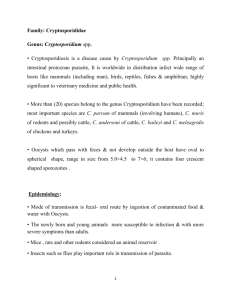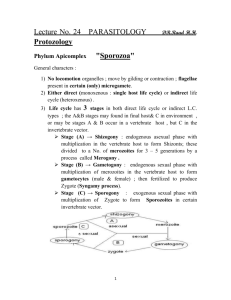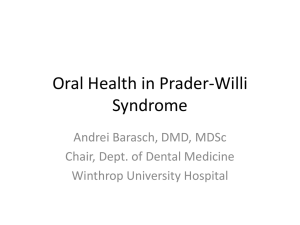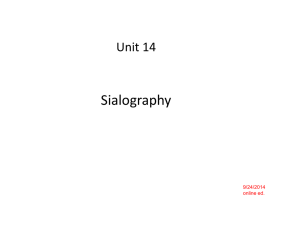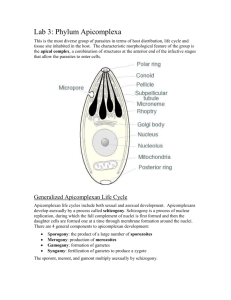The development of Plasmodium vivax oocyst to sporozoite for the
advertisement
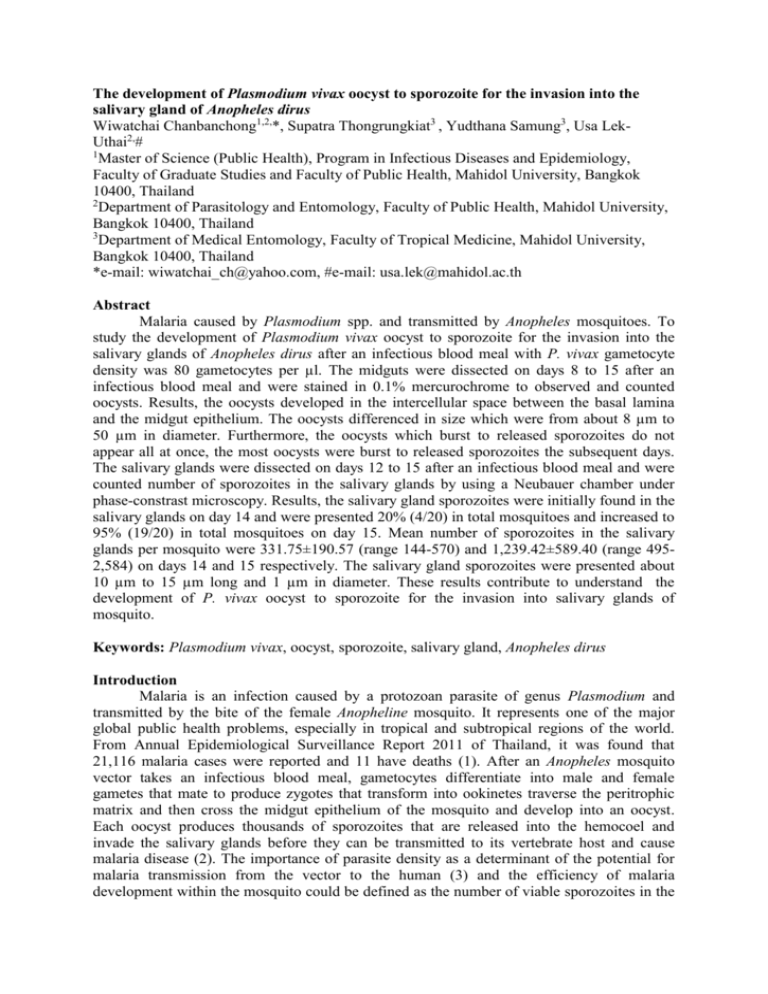
The development of Plasmodium vivax oocyst to sporozoite for the invasion into the salivary gland of Anopheles dirus Wiwatchai Chanbanchong1,2,*, Supatra Thongrungkiat3 , Yudthana Samung3, Usa LekUthai2,# 1 Master of Science (Public Health), Program in Infectious Diseases and Epidemiology, Faculty of Graduate Studies and Faculty of Public Health, Mahidol University, Bangkok 10400, Thailand 2 Department of Parasitology and Entomology, Faculty of Public Health, Mahidol University, Bangkok 10400, Thailand 3 Department of Medical Entomology, Faculty of Tropical Medicine, Mahidol University, Bangkok 10400, Thailand *e-mail: wiwatchai_ch@yahoo.com, #e-mail: usa.lek@mahidol.ac.th Abstract Malaria caused by Plasmodium spp. and transmitted by Anopheles mosquitoes. To study the development of Plasmodium vivax oocyst to sporozoite for the invasion into the salivary glands of Anopheles dirus after an infectious blood meal with P. vivax gametocyte density was 80 gametocytes per µl. The midguts were dissected on days 8 to 15 after an infectious blood meal and were stained in 0.1% mercurochrome to observed and counted oocysts. Results, the oocysts developed in the intercellular space between the basal lamina and the midgut epithelium. The oocysts differenced in size which were from about 8 µm to 50 µm in diameter. Furthermore, the oocysts which burst to released sporozoites do not appear all at once, the most oocysts were burst to released sporozoites the subsequent days. The salivary glands were dissected on days 12 to 15 after an infectious blood meal and were counted number of sporozoites in the salivary glands by using a Neubauer chamber under phase-constrast microscopy. Results, the salivary gland sporozoites were initially found in the salivary glands on day 14 and were presented 20% (4/20) in total mosquitoes and increased to 95% (19/20) in total mosquitoes on day 15. Mean number of sporozoites in the salivary glands per mosquito were 331.75±190.57 (range 144-570) and 1,239.42±589.40 (range 4952,584) on days 14 and 15 respectively. The salivary gland sporozoites were presented about 10 µm to 15 µm long and 1 µm in diameter. These results contribute to understand the development of P. vivax oocyst to sporozoite for the invasion into salivary glands of mosquito. Keywords: Plasmodium vivax, oocyst, sporozoite, salivary gland, Anopheles dirus Introduction Malaria is an infection caused by a protozoan parasite of genus Plasmodium and transmitted by the bite of the female Anopheline mosquito. It represents one of the major global public health problems, especially in tropical and subtropical regions of the world. From Annual Epidemiological Surveillance Report 2011 of Thailand, it was found that 21,116 malaria cases were reported and 11 have deaths (1). After an Anopheles mosquito vector takes an infectious blood meal, gametocytes differentiate into male and female gametes that mate to produce zygotes that transform into ookinetes traverse the peritrophic matrix and then cross the midgut epithelium of the mosquito and develop into an oocyst. Each oocyst produces thousands of sporozoites that are released into the hemocoel and invade the salivary glands before they can be transmitted to its vertebrate host and cause malaria disease (2). The importance of parasite density as a determinant of the potential for malaria transmission from the vector to the human (3) and the efficiency of malaria development within the mosquito could be defined as the number of viable sporozoites in the salivary glands (4). Previous study has reported correlation between oocyst and sporozoite number in the salivary gland of An. tessellates in both P. falciparum and P. vivax (5) However, there is a few studies in the variation and differentiation of Plasmodium oocysts to sporozoites. This is considered a crucial step toward the development of Plasmodium within the mosquito. Thus, this study describes the development of P. vivax oocysts to sporozoites for the invasion into the salivary glands of An. dirus after an infectious blood meal by using freshly blood of patients who infected with P. vivax. These results contribute to understand the development of P. vivax oocyst to sporozoite for the invasion into salivary glands of mosquito. Methods Mosquitoes rearing. The colony of Anopheles dirus were obtained from the laboratory of the Department of Medical Entomology, Faculty of Tropical Medicine, Mahidol University. They were reared and maintained at 25±1°C and 80±5% humidity with a 12h/12h light/dark cycles. Larvae were fed with larval food. Adults were provided with 10% sucrose solution (6). Malaria parasites. Blood containing gametocytes of P. vivax was obtained from malaria patients at the Hospital for Tropical Diseases, Faculty of Tropical Medicine, Mahidol University. Informed consent forms were obtained from the patients before collection and the study protocols were approved by the Ethical Review Committee for Human Research, Faculty of Public Health, Mahidol University, COA no. MUPH 2013-125. Mosquitoes infection. Three to five days old females were used to feeding, the mosquitoes were starved for 12 hours to enhance their willingness prior to feeding and they were transferred to paper cups of size 8.5 cm in diameter and 11 cm in depth (50 females per cup). The mosquitoes were fed on infected blood containing gametocytes of P. vivax through an artificial membrane feeding technique (7). The mosquitoes were allowed to feed for 30 minutes. After feeding, a cotton wool pad soaked with 10% sucrose solution was provided regularly. Mosquito dissection. The midguts of female An. dirus were dissected on days 8 to 15 after an infectious blood meal to observed oocysts and the salivary glands were dissected on days 12 to 15 after an infectious blood meal to detected sporozoites in the salivary glands respectively. Observation and counting number of midgut oocysts were dissected, stained with 0.1% mercurochrome and examined (400x). Sporozoites were observed and counted from whole salivary glands individual mosquitoes. Salivary gland sporozoites were dissected from salivary glands and homogenized in cell tissue grinder with phosphate buffered saline (PBS, pH 7.2) and centrifuged at 26g for 3 minutes to extract mosquito debris, sporozoites were collected from the supernatant and counted using a Neubauer chamber under phaseconstrast microscopy (400x) (8). Results In this study, we observed the development of P. vivax oocysts to sporozoites for the invasion into salivary glands of An. dirus. Approximately of P. vivax infected blood samples in total parasite density and total gametocyte density were 160 parasites/µl and 80 gametocytes/µl respectively (total parasite density and total gametocyte density were calculated by determining the number of parasites per 200 WBCs). After mosquitos were fed on blood infected P. vivax by using an artificial membrane feeding technique, the percentage with oocysts were presented 95% (19/20) on days 12 and 13 which can be detected mean number of oocysts per infected midgut were 13.63±9.87 (range = 3-45) and 13.57±7.74 (range = 3-32) respectively and the percentage with oocysts were 75% (15/20) and 15% (3/20) on day 14 and 15 which can be detected mean number of oocysts per infected midgut were 8.26±6.02 (range = 1-19) and 1.66±0.57 (range = 1-2) respectively. Moreover, the percentage with sporozoites invading the salivary glands of mosquito on day 14 and 15 were 20% (4/20) and 95% (19/20) which can be detected mean number of sporozoites were 331.75±190.57 (range = 144-570) and 1,239.42±589.40 (range = 495-2,584) per mosquito respectively. During days 12 to 13 salivary glands dissection, the observation was not found sporozoites in the salivary glands (Table 1). Table 1. Number of oocysts and sporozoites detected from the mosquitoes at days 12 to 15 after an infectious blood meal Day after an infectious blood meal Mean number of oocysts per infected midgut (range) Percentage with oocysts 12 13.63±9.87 (3-45) 13.57±7.74 (3-32) 8.26±6.02 (1-19) 1.66±0.57 (1-2) 13 14 15 Percentage with sporozoites invading the salivary glands 95 (19/20) Mean number of sporozoites in the salivary glands per mosquito (range) NF 95 (19/20) NF NF 75 (15/20) 331.75±190.57 (144-570) 1,239.42±589.40 (495-2,584) 20 (4/20) 15 (3/20) NF 95 (19/20) N = 20 mosquitoes. NF = not found. Oocysts at different stage of development to sporozoites were observed on day 8 to 15 after an infectious blood meal by an artificial membrane feeding technique using freshly blood of patients who infected with P. vivax. The development of oocysts undergone multiple nuclear divisions. Result in a multinucleated parasite that gradually grown in size was shown. In parallel to this process replication, the oocyst plasma membrane is folded inwards and forms crevices that, extending across the oocyst cytoplasm, partition it into compartments termed sporoblasts (Figure 1D and 1E). The development of sporozoites bud off from the sporoblasts in a process that involves the mobilisation of nucleus and other cellular organelles into each budding sporozoite. Throughout oocysts growth, the oocyst capsule is a bilayered structure with a thick outer wall derived from the mosquito basal lamina. In young oocysts the wall appeared smooth. The mature oocysts had a more wrinkled surface structure (Figure 1H and 1I) compared to younger ones (Figure 1A to 1D). The cyst wall of mature oocysts become thinned out (Figure 1H and 1I), weakened and the sporozoites emerged through the cyst wall and basal lamina. The structure of oocyst during growth presented linearly from about 8 µm to 50 µm in diameter. Oocysts development was completed with the production of several hundreds sporozoites by synchronous budding out of the sporoblasts. Sporozoites released from the oocysts and migration to the salivary glands of mosquito was the next important step in malaria transmission (Figure 1J). The sporozoites were presented about 10 µm to 15 µm long and 1 µm in diameter. Figure 1. Oocyst appearance illustrating the locations of oocyst characteristic different observed within the midguts of Anopheles dirus at days 8, 10, 12, 13, 14 and 15 after an infectious blood meal (A, B, C-D, E-F, G-H and I) respectively by stained with 0.1% mercurochrome. The sporozoites (J) located in different regions of the salivary glands of An. dirus by stained with 10% Giemsa . Bar = 15 µm. Figure 2. The development of Plasmodium vivax in Anopheles dirus after artificial membrane fed. (1) The mosquitoes were fed with infected-blood containing gametocytes through an artificial membrane feeding technique. (2) Within the midgut lumen of mosquito, gametocytes differentiated into gametes that mate to form zygote and later motile ookinete to exit the mosquito midgut lumen, ookinetes traversed the midgut epithelium and lodge beneath the basal lamina where they differentiated into oocysts. (3) The oocysts undergone multiple nuclear divisions and formed sporoblasts , gradually grown in size from young to mature oocyst. (4) Sporozoites were released from oocysts enter the haemocoel (5) and invaded into the salivary glands of An. dirus that initially found in the salivary glands on day 14 under laboratory conditions. Discussion and Conclusion In this study, the sporozoites were initially found in the salivary glands on day 14 and they were presented 20% (4/20) in total mosquitoes and increased to 95% (19/20) in total mosquitoes on day 15. These results are consistent with an earlier study by Dawes et al. (9) who studied the temporal dynamics of Plasmodium through the sporogonic cycle within Anopheles mosquitoes, found that the oocysts which burst to release sporozoites do not do so all at once but over a number of days and sporozoites were initially found in the salivary glands on days 12-14 and increased in number relatively quickly over the subsequent days. Similarly, Zollner et al. (10) studied the population dynamics of sporogony for P. vivax in Anopheles mosquitoes and they found that sporozoites invaded into the salivary glands occurred at day 14. These results suggest in collection massive of sporozoites in the salivary glands of An. dirus should be collected at day 15 or the subsequent day after the day at initially found in the salivary glands. Here, During days 12 to 13 salivary glands dissection, the observation was not found sporozoites in the salivary glands which may be possible that number of sporozoites has a little which can not directly counted. The checking may use other techniques to detected such polymerase chain reaction technique (PCR), was based on the detection of nucleic acid sequences specific to Plasmodium to checked sporozoites in a small number. However, the understanding of the development of P. vivax oocyst to sporozoite of An. dirus will lead to a better reasons for the variation and temporal changes of P. vivax within mosquitoes to invade into the salivary glands of mosquito before it can be transmitted to its vertebrate host and cause malaria disease. Questions are still remain about the mechanisms of sporozoite in the invasion into the salivary glands of mosquito. How the sporozoite make contact with and enter the salivary glands of mosquito. For example, MAEBL (apical membrane antigen/erythrocyte binding like protein) should be studied. It localizes to micronemes and the surface of late oocysts and sporozoites, is the sporozoite protein with an important role in the recognition and binding in the invasion into salivary glands of mosquito (11-13). These can be a useful results for to study the evaluation of midgut oocyst numbers and the determination of the oocyst stage development in parasiteinfected mosquitoes and may use for the development of the malaria parasite in its mosquito vector which is essential for the new vector control measures. This study has one important limitation. Blood containing gametocytes was only obtained from malaria patient who seeking treatment at the Hospital for Tropical Diseases, Faculty of Tropical Medicine, Mahidol University. It has low parasites and gametocyte (total parasite density and total gametocyte density were 160 parasites/µl and 80 gametocytes/µl respectively). Obtaining blood from patient with higher parasites and gametocytes would likely improve and more efficiently produce oocysts and sporozoites yield to be study. Reference 1. 2. 3. 4. 5. 6. Bureau of Epidemiology. Annual Epidemiological Surveillance Report 2011. Nonthaburi Thailand: Ministry of Public Health, 2011. Ghosh A, Edwards MJ, Jacobs-Lorena M. The journey of the malaria parasite in the mosquito: Hopes for the new century. Parasitol Today 2000; 16:196-201. Medica DL, Sinnis P. Quantitative dynamics of Plasmodium yoelii sporozoite transmission by infected Anopheline mosquitoes. Infect Immun 2005; 73:4363-9. Rosenberg R, Rungsiwongse J. The number of sporozoites produced by individual malaria oocysts. Am J Trop Med Hyg 1991; 45:574-7. Gamage-Mendis AC, Rajakaruna J, Weerasinghe S, Mendis C, Carter R, Mendis KN. Infectivity of Plasmodium vivax and P. falciparum to Anopheles tessellatus; relationship between oocyst and sporozoite development. Trans R Soc Trop Med Hyg 1993; 87:3-6. Zhao YO, Kurscheid S, Zhang Y, Liu L, Zhang L, Loeliger K, et al. Enhanced survival of Plasmodiuminfected mosquitoes during starvation. PLoS One 2012; 7:e40556. 7. 8. 9. 10. 11. 12. 13. Chomcharn Y, Surathin K, Bunnag D, Sucharit S, Harinasuta T. Effect of a single dose of primaquine on a Thai strain of Plasmodium falciparum. Southeast Asian J Trop Med Public Health 1980; 11:408-12. Solarte Y, Manzano MR, Rocha L, Hurtado H, James MA, Arévalo-Herrera M, et al. Plasmodium vivax sporozoite production in Anopheles albimanus mosquitoes for vaccine clinical trials. Am J Trop Med Hyg 2011; 84:28-34. Dawes EJ, Zhuang S, Sinden RE, Basáñez MG. The temporal dynamics of Plasmodium density through the sporogonic cycle within Anopheles mosquitoes. Trans R Soc Trop Med Hyg 2009; 103:1197-8. Zollner GE, Ponsa N, Garman GW, Poudel S, Bell JA, Sattabongkot J, et al. Population dynamics of sporogony for Plasmodium vivax parasites from western Thailand developing within three species of colonized Anopheles mosquitoes. Malar J 2006; 5:68. Saenz FE, Balu B, Smith J, Mendonca SR, Adams JH. The transmembrane isoform of Plasmodium falciparum MAEBL is essential for the invasion of Anopheles salivary glands. PLoS One 2008; 3:e2287. Srinivasan P, Abraham EG, Ghosh AK, Valenzuela J, Ribeiro JM, Dimopoulos G, et al. Analysis of the Plasmodium and Anopheles transcriptomes during oocyst differentiation. J Biol Chem 2004; 279:5581-7. Kariu T, Yuda M, Yano K, Chinzei Y. MAEBL is essential for malarial sporozoite infection of the mosquito salivary gland. J Exp Med 2002; 195:1317-23.
